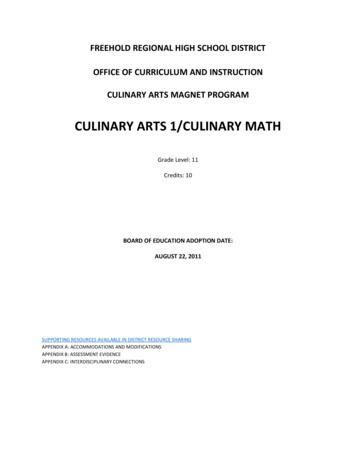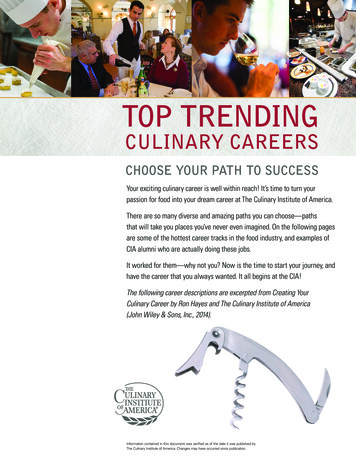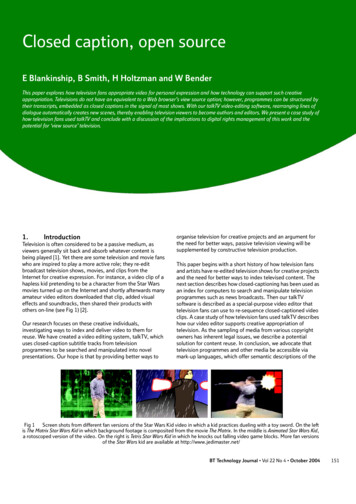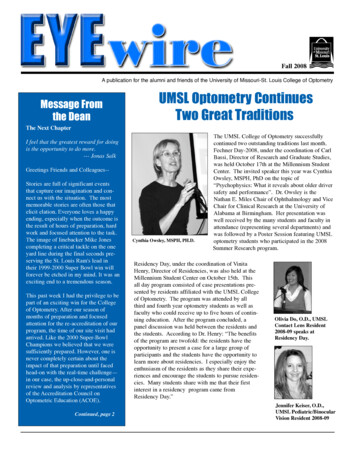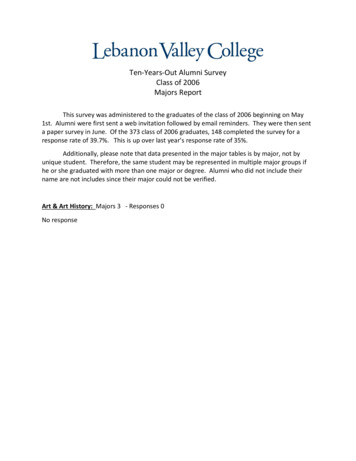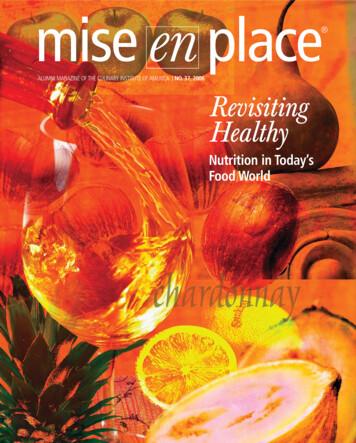
Transcription
ALUMNI MAGAZINE OF THE CULINARY INSTITUTE OF AMERICA NO. 37, 2006RevisitingHealthyNutrition in Today’sFood World
WELCOME FROM THE DIRECTORSteve Swofford ’97, EXECUTIVE DIRECTOR OF ALUMNI RELATIONSALUMNI MAGAZINE NO. 37, 2006Kirsten Nielsen, Graphic DesignerJim Norman, Senior WriterContributing WritersJay BlotcherShelly LovelandVictoria RiccardiNikki Rose ’94Marianne Turow ’83Patrick Wilson ’91The Culinary Institute of AmericaDr. Tim Ryan ’77, PresidentAcademic AffairsDr. Peter Rainsford, Vice PresidentAdvancementDr. Vance Peterson, Vice PresidentHealth and wellness.vegan diets.obesity.global flavor profiles.trans fats.We’ve all been inundated with the buzzwords so often associated with nutrition and healthin the food industry. The notion of nutrition and healthful cuisine—so different today thanit was even when I was a CIA student—is constantly evolving. What is the CIA doing tostay on top of this critical component of our profession, while staying true to the college’score values? How are our faculty and alumni getting involved? What are some of thechanges in store for the future?Continuing EducationMark Erickson ’77, Vice PresidentEnrollment ManagementDrusilla Blackman, DeanIn this issue of mise en place , we explore these and other questions as we “revisithealthy” in 2006. Many of your fellow alumni are making fascinating, meaningful contributions to health and nutrition. NIKKI ROSE ’94, one of our globe-trotting grads, explores thebenefits of the Mediterranean diet. CIA Associate Professor and Registered DietitianMARIANNE TUROW ’83 offers some thoughts on the subject of obesity in our country. AndFinance & AdministrationCharles A. O’Mara, Senior Vice PresidentHuman ResourcesDavid Jaskiewicz, Vice PresidentLiberal & Management StudiesDr. Kathleen M. Merget, DeanVice President of Continuing Education MARK ERICKSON ’77, C.M.C. talks about some ofthe ways the CIA is working to help educate the world about healthy foods.So sit back, relax, and grab a (healthy) snack. Enjoy reading about your classmates,about your alma mater, and about the wonderful, flavorful world of healthy cuisine.Here’s to health!Marketing & StrategyBruce Hillenbrand, Vice PresidentPlanning, Research, & AccreditationDr. Ann A. Weeks, Associate Vice PresidentStudent AffairsAlice-Ann Schuster, Dean 2006 The Culinary Institute of AmericaAll rights reserved.Printed in the United States of America.mise en place is a registered trademark ofThe Culinary Institute of America,1946 Campus Drive, Hyde Park, NY 12538-1499.The CIA at Greystone is a branch of the CIA,Hyde Park, NY.Photography: Melanie Acevedo; Cornell University Photography; Bill Dennison; Keith Ferris; Ben Fink; Eric Futran; TerrenceMcCarthy; On Location Studios, Inc.; Patricia “Scout” Owen; Lorna Smith; and Paul TalleyOn the Cover: Visual Cuisines, Inc.Back Cover Illustration: Beverly Colgan
TABLE OF CONTENTSFeatures591212Cooking Up a RevolutionWhat’s theMediterranean Diet?CIA Hosts Worlds ofHealthy FlavorsTake a Bite Out of ObesityThe Culinary’s Vice President forContinuing Education MarkCIA alumna Nikki Rose ’94Nutrition scientists, chefs, andAssociate Professor MarianneErickson ’77 talks about the col-shares her thoughts on the bene-culinary experts gather atTurow ’83 urges the food com-lege’s current and future role infits of the Mediterranean dietGreystone to explore new waysmunity to fight the good fighthealth and nutrition.after extensive travel throughoutto bring healthy cuisine toagainst obesity in the U.S.the region.American consumers.Registered Dietitian and CIADepartmentsTHE INFORMATION EXCHANGEYou’ll find “The Information4Exchange” on the insert in thisFAMILY MEALCIA President Tim Ryan ’77 kicks off his new regular mise en place column by spotlighting the college’sleadership in health and nutrition education.issue. We’d love to hear what’sgoing on in your professionaland personal life, so if there’s13anything new to report, pleaseCIA NEWSNew Admissions Building 60th Anniversary celebration continues Jones Dairy Farm Kitchendedicated CIA-Cornell alliance and collaborative degree Annual golf classic Alumni Acrosscomplete the form and return itAmerica Day Guarding the CIA brandto the Alumni Relations Office.19MAKING A DIFFERENCEAlumni Mentor Program Alumni giving helps students CIA student earns MenuMastersScholarship Eisch, American Roland, and Wine Enthusiast make generous gifts Alumni Championsanswer the call23PROFESSIONAL DEVELOPMENTProChef Certification helps advance graduate’s career Culinary Immersion provides kitchen insight tofront-of-the-house professionals CIA offers two new books and a DVD for culinary training26WHATEVER HAPPENED TO.Updates on classmates Alumni feature stories In memoriam Alumni award-winners
FAMILY MEALFamily Meal WITH CIA PRESIDENT TIM RYAN ’77“To eat is a necessity, but toeat intelligently is an art.”French nobleman and writer Françios de La RochefoucauldFor more than 60 years, The Culinary Institute ofAmerica has done its part to transform the concept ofeating from something we have to do to something wecan really enjoy doing. But today, with more and morepeople dining out and seeking healthier menu choices, the challenge is greater than ever to present foodthat’s not only fun, but nutritional. It’s up to us in thefoodservice industry—and at the CIA—to help consumers “eat intelligently” without sacrificingquality and flavor.I’m happy to report that our college has madehealthy contributions to this cause in many ways.Twenty years ago, the CIA began setting the standardfor nutritional cuisine with the opening of St.Andrew’s Café on its Hyde Park, NY campus.Students gained experience in a wide variety ofhealthy cooking styles and ingredients as theyexplored creative flavor combinations, grillingtechniques, and ethnic dishes from Asia and theMediterranean.The college continued to make nutrition a vitalpart of the curriculum when it received a 1 milliongrant in 1988 from The General Foods Fund to buildthe General Foods Nutrition Center, a facilitydesigned to encourage education and research innutritional cooking. Providing a new home for St.Andrew’s, the Center also offered lecture rooms, ateaching kitchen, and a computer laboratory thatintroduced students to nutritional analysis andthe fundamentals of healthy menu and recipedevelopment.But all of that was just the beginning. Today we notonly have three nutrition-focused courses—AdvancedConcepts in Nutrition, Nutrition, and NutritionalCooking—in our degree program curricula, but weintegrate health and nutrition into all facets of theeducational experience for students, from flavor profiles to food preparation to global cuisines.4 REVISITING HEALTHYFood professionals turn to the CIA as well forexpertise in the area of health and nutrition. Ourtextbook, The Professional Chef’s Techniques of HealthyCooking, became the key resource for thousands ofchefs seeking a solid grounding in nutritional principles and recipes to expand their repertoire of healthychoices. Our popular DVD training tool—“TheHealthy Palate: Information That Leads to a HealthyBottom Line”—features the CIA’s chefs, nutritionists,and researchers taking a fresh look at how to preparefood that is both healthy and flavorful, combinedwith information from the USDA and the HarvardSchool of Public Health (HSPH).Speaking of the HSPH, we collaborated with themto stage the second annual Worlds of Healthy Flavorsleadership retreat earlier this year at the Greystonecampus. The extraordinary event drew leading nutrition experts from around the country to discuss waysto increase the scope and range of healthy menuchoices available to American consumers.We also joined forces with the Produce for BetterHealth Foundation in January to host a conference atGreystone. The “Produce First! American Menus”Initiative brought together key leaders from the foodservice and produce industries to develop strategiesfor providing new menu options using fruits andvegetables.All of these education programs and initiativesunderscore the CIA’s strong leadership role in thehealth and nutrition segment of foodservice. As alumni, you should be proud not only of all that your almamater is contributing to this wide-reaching endeavor,but of everything you and your fellow graduates aredoing in the industry to make nutritional cuisinemore accessible and palatable to consumers. Theworld is our canvas and, together, we will continueto master the art of eating intelligently.
COOKING UPA REVOLUTIONMark Erickson Trains Tomorrow’s Chefs to Help Us Eat BetterBY VICTORIA RICCARDI; originally published in Eating Well magazineIt’s hard to believe that eating well is ever an issue forMark Erickson, the vigorous vice president for continuingeducation at The Culinary Institute of America (CIA).After all, when you work at a place training the futureSara Moultons of the world—as well as, perhaps, the nextRay Kroc (founder of McDonald’s)—chances are there’ssome pretty good grub around. And there is, right outsidehis offices on the CIA campuses at Hyde Park, NewYork, and at St. Helena, in California’s Napa Valley.WWhich is part of the problem: because Erickson’swork involves significant travel, including commuting between both campuses, he’s often in transit—hungry and looking for a wholesome meal. “Whatreally frustrates me is going through an airport;you have to be very careful, very selective, andreally work hard to find healthy foods,” saysErickson. “I tend not to eat.”This will soon change, however, if Erickson hashis way. Charged with helping the CIA positivelyinfluence the way Americans eat, Erickson, whograduated from the CIA in 1977 and has workedthere on and off since 1984, has several programsin the works, largely at Greystone, the Californiacampus.Roughly 3,500 students a year pass throughGreystone’s doors to hone their skills in the food,wine, health, and hospitality fields. Last year thecampus added the Ventura Foods Center for MenuResearch and Development to help the foodservice industry wise up in a variety of areas, including health and wellness. It’s also home to theWilliams Center for Flavor Discovery, founded tobetter understand the cuisines of countries withinnately healthy diets. This venture has spawned apartnership with the Harvard School of PublicHealth, which for the past two years has cohosteda “Worlds of Healthy Flavors” conference to helpindustry leaders incorporate good nutrition intotheir businesses.With Americans spending more than half oftheir food dollars in restaurants these days,Erickson—an avid mountain biker who’s known forhis innovative thinking and affable manner—is in aprime position to help change the way Americanseat, not only in the gourmet restaurants we oftenassociate with CIA graduates, but also in chainslike McDonald’s or T.G.I. Friday’s.mise en place no. 37 5
Q:How does today’s CIA compare to the oneyou graduated from in 1977?We’re still committed to the same core values—professionalism and high-quality food—but the industry now has many different layers to it. Today, alarge percentage of our restaurants in America arerun by chain operations, which are looking todevelop an extremely demanding, consistent product, with price-point expectations. The CIA’s curriculum today also prepares students to addressthese challenges at a leadership level.Q:You’ve said that customers’ concerns aboutdiet and health—and their appetite forflavor and adventure—are reshaping thefoodservice industry. Are these two trendscompatible?Absolutely. The trend we’ve seen for the past 20years is to take a dish we all recognize asunhealthy, then remove all the unhealthy aspectsof it. So, say, fat was the enemy, then we’d take allthe fat out. Frankly, that leaves the food, in mostcases, pretty unsatisfying from a flavor standpoint.So the approach we are working on is to looktoward the kinds of dishes, flavors, and texturesfound in cuisines with healthier profiles versusthose from central and northern European countries, which we tend to eat a lot of in America.We’re focused on three key areas—Asia, theMediterranean (especially the southern and eastern rim), and Latin America.6 REVISITING HEALTHY“I truly believe our industry wantsto do the right thing when it comesto health and wellness.”Q:A recent report found that there has beensome “backsliding” when it comes to healthyoptions in restaurants. For example, RubyTuesday removed smaller-portion optionsfrom its menus after only five months, callingit a “failed experiment.” How can the CIAhelp make healthy food more sellable, yetprofitable?I truly believe our industry wants to do the rightthing when it comes to health and wellness. Butthey’re still a business—and investors want to knowthat their company is growing. Typically, the wayto do that is to create more restaurants, serve morepeople, or increase the amount of the averagecheck. To increase the check average you mustincrease the dollar amounts of what you’re charging, and then you have to thread that back to whatyour customers believe to be the value equation:‘What did I pay for versus what did I get?’Unfortunately, it’s very common in our industry forrestaurateurs who are trying to increase sales toincrease the portion size—which satisfies the customer in terms of the value equation.
Q:What can the CIA do to counter this?We’re trying to get the restaurant industry torecognize that large portion sizes are not the wayto go—because there is a point where you can’tmake the portions any bigger, and we’ve sort ofreached that point. So we’re communicating to theindustry that maybe they should be focusing onthe quality of the serving for the price.Q:How do restaurants boost quality?They do it by offering more variety andby keying in on what their customers perceiveas value aside from portion size. Look atMcDonald’s: they successfully launched theirPremium Chicken Sandwiches at a higher pricepoint than anything they’ve ever served before,and they’re doing very well with that.Q:Do chefs have a responsibility to shapepeople’s attitudes about food and health?Ultimately the customer is responsible for eatingright. However, I do think it’s our responsibilityto offer healthy choices.Q:Are there any tangible changes that haveoccurred as a result of these conferences?Absolutely. For most of the attendees at the[Worlds of Healthy Flavors] conference in 2004,trans fat wasn’t even on the radar screen. When weheld our second conference [in 2005], we had a lotof return operators and every single one of themwas in some stage of eradicating trans fats fromtheir food systems.Each conference drew about 35 very large operators, who we estimated represent somewherebetween 150 and 250 million meals servedeach day.mise en place no. 37 7
Q:Aside from these conferences, what otherprograms are you working on?We are developing a book for consumers that willfocus on techniques and flavors for healthier eating. It will be heavily influenced by some of theseethnic dishes we’ve discovered and been workingwith. We also have a DVD series called “Flavor ofHealth,” for professionals.We’ve also been working with the HarvardMedical School [HMS] to develop a program notonly about healthier cooking, but about healthierlifestyles. So often people want to be healthier, butthey can’t get there because we don’t give themthe tools for changing their behaviors—such asguidelines for shopping for the right foods or making healthy menu choices when dining out. Ouraim with HMS is to figure out what the messagesare and the best way to effectively changebehavior.We also recognize that doctors don’t have thetraining in nutrition that they could use to bettercommunicate positive health messages. So we’redeveloping a continuing education program withHMS to train doctors.8 REVISITING HEALTHYQ:Five years from now, what kinds of changesin the food industry would you like to see?I’d like to see that trans fats aren’t even beingtalked about anymore because they’ve beendrummed out of the food system. I’d like to seerecognition that not all fats are bad, and less focuson the percentage of fat and carbohydrates andmore about the quality of fats and carbohydrates.I’d like to see us having made real progress interms of understanding that health and wellnessapplies to the whole menu, not just a couple ofitems that are flagged with all kinds of health messages (that nobody orders).And I’d like to be able to walk through an airport and have lots of options for healthier foods. 쏄Victoria Riccardi is a frequent Eating Well contributor.From www.eatingwell.com with permission. 2006 Eating Well Inc.
What’s the Mediterranean Diet.and Who’s On It Anyway?BY NIKKI ROSE ’94Originally published in Stigmes Magazine (Greece); abridged for mise en place The Mediterranean Sea touches the shores of manydiverse countries. There are cultural, agricultural,environmental, religious, and economic influencescomprising a vast banquet. Promotion of exportsfrom the region has washed away culture withwaves of statistics on olive oil consumption and afew key ingredients available elsewhere.TThe window into other cultures is through thekitchen. America has wonderful regional cuisine,even though it’s dubbed the burgers and friesnation abroad. It’s challenging to argue that fact.Turn the tables and consider the sweeping generalizations of the Mediterranean Diet.The History of The DietThe Diet phenomenon began in the late 1950sthrough the research of Dr. Ancel Keys, anAmerican physiologist and initiator of the K-rationmeals during World War II. Keys discovered thatthe cardiovascular disease and cancer rates in menliving in rural Crete were surprisingly low andthey lived long, healthy lives. He noted that theyconsumed high quantities of olive oil, but also considered cuisine and lifestyle as a whole.Dr. Keys conducted a 15-year comparativestudy of these disease rates in Greece (only Creteand Corfu), Finland, Japan, Italy, the Netherlands,the United States, and Yugoslavia (known as the“Seven Countries Study”). The results provedhis theory of low instances of either disease inCrete and high instances in all other countries,except Japan.The Cretan Diet was launched, which is confusingly referred to as the Mediterranean Diet. Oliveoil was cited as a piece of the puzzle but otherimportant pieces were lost. The Diet conceptspread throughout the Med, whether countriespracticed it or not.Crete is an arid, mountainous, rockyisland with only a few major cities.this is farming and fishing country.For instance, the higher cardiovascular diseaserates in France and Italy do not coincide with theCretan Diet’s premise. They enjoy similar cuisinebut also consume many products on the healthydiet moderation list that you never see in Crete.Italy also buys extra virgin olive oil in bulk fromGreece, mixes it with their production, then sells itunder Italian brand names. In France, for over adecade, doctors have placed groups of cardiovascular disease patients on the traditional diet ofCrete (not Provence) with positive results.mise en place no. 37 9
The interpretations of the Med Diet have hadlittle impact on the rise of diet-related health problems. Just within the isle of Crete the cuisine differs by region and there are great stories behindtraditional dishes dating back thousands of years.Geography, Climate, and Lifestyle Shape CuisineSince these studies emerged, things have changed.What hasn’t changed much is the geography andclimate. Crete is an arid, mountainous, rockyisland with only a few major cities. Aside from seasonal tourist resorts and metro areas with modernsupermarkets, this is farming and fishing country.Olive and nut groves, orchards, grape vines,and greenhouses cover nearly every inch of available land.Wild artichokes, fennel, purslane, dandelion,chicory, nettle, berries, poppies, oregano, thyme,sage, and chamomile blanket the countryside.Many residents enjoy the free food, including wildgame. The summers are long, hot, and dry andwinters are relatively mild with snowfall only inthe mountains. The climate is somewhat similar toNapa Valley, but Crete is surrounded by salty seasand the winds they carry.The produce is plentiful with intense concentrated flavor and color. The down side (for farmers, not holiday makers) is this seasonal drought.Olive trees grow miraculously out of dry, rockyearth. There are approximately three million olivetrees in Crete. The terrain is unfit for cows—beefproducts are luxury imports.Deep green, robust extra virgin olive oil is produced in even the smallest villages, usually only byand for the community. Residents do not purchaseolive oil in supermarkets—they produce it themselves or know someone who does. Several cooperatives export olive oil and have won top qualityawards in international competitions. Olive oilhas been produced on Crete for about four thousand years—the Minoans exported it throughoutthe region.10 REVISITING HEALTHYFrequent exercise is the key to a healthylifestyle, so consider the labor involved in farmingthe landscape of Crete. Whether or not people arefarmers by trade, many have a patch of land forproduce and livestock to feed the family. For practical reasons and personal preference, they mightalso make their own bread, cheese, yogurt, vinegar,wine, etc., in between their day jobs at the bankor hotel.Fresh seafood consumption is clearly moreprevalent in the coastal villages, although over-fishing is a problem today. Many villages are hiddenin the mountains as a result of Crete’s history offoreign invasions. Hence, traditional dishes arebased on survival tactics and the art of foragingfor food in the wild.Settlements existed long before the automobileor refrigeration, yet traditional cuisine is not budging yet. Some dishes stem from mythology, traderoute fusion, occupation, and/or religious holidayswhen consumption of meat and dairy products isprohibited for long periods of time. Greeks following religious dietary doctrines are part-time vegetarians. Times are changing, but we still have achance to discover why this pocket of the world isso important to the scientific community—and us.Scientific Application in Action: Eating in Rural CreteEvery day on the traditional Cretan table, there isa selection of five or six simply prepared wild andcultivated vegetables as part of a small or grandmeze. It’s the opposite of the American concept ofmeat, starch, then vegetables. Simple seasonal salads with tomatoes, cucumber, purslane, green pepper, onion, and olives are common, yet many vegetables are also served separately. Sweet and hotpeppers, beets, greens, artichokes, okra, zucchini,and eggplant are hot ticket items.Dried beans or seeds are popular—fava, yellowsplit peas, broad beans, chickpeas, and lentils.Some are just cooked until tender, coarselymashed, and served with olive oil, chopped onion,and salt. Fresh or dried (paximadi or dakos) wholegrain bread is always on the table. The finale is
seasonal fruit (not baklavas, etc.) like cherries,watermelon, grapes, figs, pomegranate, pricklypears, loquat, apples, and oranges. A shot of tsikoudia or raki, a locally distilled version of grappa,often arrives with the check.Yes, there’s the grilled chicken, pork, or lamb(souvlaki). But there are things Cretans eat on aregular basis that are rarely mentioned in fancyfood publications—snails, new almonds, raw broadbeans and artichokes, octopus, sardines, smelts,and other small, whole fish (crispy heads, bones,fins, and all are consumed). Braised goat or wildhare and fowl, sausages, and meats from head tofoot are served on occasion.Potatoes, pasta, barley, stone ground wheat, andrice are prepared in different ways. Potatoes arejust baked or fried in a little olive oil, or braisedwith other vegetables. Seasoned rice is used as astuffing for different vegetables.Yogurt is eaten straight, used in sauces, ortopped with fresh fruit, walnuts, or a generous portion of aromatic Cretan honey. Traditional Greekyogurt is made from sheep and/or goat milk, andit’s thick like baked pudding. Most fat (or flavor) isnot extracted.Cheese is a standard accompaniment to meals.There are many types (via sheep or goats). The listis long with homemade variations of feta, mizithra(a soft fresh cheese), kasseri, and kefalotiri (similarto Romano). Snacks include fresh or dried fruitsand nuts like figs, apricots, raisins, peanuts, walnuts, almonds, and roasted chestnuts. Last but notleast are beloved olives—large or small; green, purple, or black; preserved in brine; sea salt or not.Wine is a given—generally consumed in moderation with food. Some men drink quite a bit ofraki and are well over 80 years of age but it’s hardto guess how healthy they are. Most Cretanwomen consume very little alcoholic beverages,unless it’s in their homemade desserts.Cooking TechniquesCretan cuisine is based on technique rather thanrecipes. Grilling is the number one choice here—we’re back to some ancient basics. The nutritionalbenefit is that the fat drips to the ground. Outdoorstone ovens are used for bread baking and roasting. No complicated recipes are used—olive oil,lemon, and herbs. Pungent dried oregano from thecountryside is liberally used.Tomatoes are a prevalent, yet recent additionfrom the new world. Aside from enjoying themduring the long growing season, cooks make abasic tomato sauce for braising meat or fish witha variety of vegetables, starches, or beans. It’s athin sauce that imparts subtle flavor and retainsnutrients.A standard vegetable prep lets the food speakfor itself—simmered and seasoned with olive oil,lemon juice, and salt. Other seasonings are usedon certain vegetables. A pinch of fresh or dried hotpeppers is more common than black peppercorns.Horta, a seasonal combination of cultivated andwild greens, is simmered and served with a littlecooking liquid and—you guessed it—lemon, oliveoil, and salt. A modern variation is to sauté greensin olive oil with garlic, leeks, and herbs. Greensare prevalent in savory pastries called hortapitas.Fresh spinach pie or “spanakopita” is a rarity—it’snot worth cultivating. Try combinations of kale,collards, chard, beet, or arugula, bearing in mindthe difference in cooking time.Complex casseroles with meat and béchamelsauce (i.e., moussakas, a Turkish word) are also ararity in Crete. Using cooking techniques as yourguide to experimenting with Cretan ingredientsopens up the world of cuisine. There’s a basic formula to which you add your imagination. 쏄Nikki Rose ’94 is program director for Crete’s Culinary Sanctuaries, which offerstravel programs to Greece.Copyright Nikki Rose. All rights reserved.mise en place no. 37 11
CIA Hosts Worlds of Healthy Flavors RetreatA prestigious group of leading Americannutrition scientists, corporate chefs, andfoodservice menu decision-makers, together with other culinary experts, gatheredlast January for the start of the SecondAnnual Worlds of Healthy FlavorsLeadership Retreat, presented by TheCulinary Institute of America (CIA) andHarvard School of Public Health—Department of Nutrition (HSPH).The invitational CIA-HSPH program,held at the CIA at Greystone campus inCalifornia’s Napa Valley, is part of a continuing joint CIA-HSPH initiative toincrease the scope and range of healthymenu choices available to consumersthrough American foodservice.Heading up the project’s ScientificAdvisory Committee and co-chairing theCalifornia conference is Walter Willett,M.D., Dr.P.H., chairman of the Departmentof Nutrition at Harvard School of PublicHealth, and author of Eat, Drink andBe Healthy: The Harvard Medical SchoolGuide to Healthy Eating.12 REVISITING HEALTHY“At a time when American foodserviceaccounts for a full 50% of the consumerfood dollar, it is essential that we see moreleadership in this sector to promotehealthier menu choices,” Dr. Willett said.“This is why we are excited to be collaborating with the CIA on this opportunityfor the scientific community to workdirectly with key foodservice organizationsin affecting how tens of millions ofAmericans eat every week.“Part of our challenge is the continuingconfusion in the public at large aboutoptimal diets for chronic disease prevention,” he continued. “This initiative provides a common ground for leading edgescientific research and a platform onwhich scientists, chefs, and operatorscan come together to accelerate healthyinnovation.”And come together they did. Theretreat drew a wealth of top talent from adiversity of disciplines, including nutritionscientist Frank Sacks, M.D. and other faculty of the Harvard School of PublicHealth; as well as Janet King, Ph.D., R.D.and Ronald Krauss, M.D. of the Children’sHospital Oakland Research Institute.Culinary experts included John Ash,California-based chef and author;Musa Dagdeviren, chef and EasternMediterranean culinary expert, Istanbul,Turkey; Suvir Saran, author and co-executive chef, Devi restaurant, New York City;Mai Pham, author and chef/owner, LemonGrass Restaurant, Sacramento, CA; andCIA faculty members Adam Busby, C.M.C.,Robert Jörin, and Stephen Durfee.CIA graduate R. Douglas Martinides ’75,vice president, ARAMARK Corporation,was among the more than 35 senior foodservice industry representatives who participated in the two-day gathering.You can find full coverage of this leadership retreat—including streaming videopresentations, interviews, a showcase ofbest industry practices, and recipes—at theCIA’s www.ciaprochef.com Web site. 쏄Take a BiteOut of Obesityby Marianne Turow ’83, R.D., C.H.E.Associate Professor in NutritionOne of the most challenging health issues we face asa nation today is obesity. Obesity and “overweightness” has reached epidemic proportions in this country. As food professionals, we’re in a unique positionto help stem this tide.Recent studies indicate that 64% of Americanadults are overweight or obese. A calculation tool thatis used for this measurement is the BMI,
ALUMNI MAGAZINE OF THE CULINARY INSTITUTE OF AMERICA NO. 37, 2006 Revisiting Healthy Nutrition in Today’s Food World. Steve Swofford ’97, . front-of-the-house professionals CIA offers two new books and a DVD for
